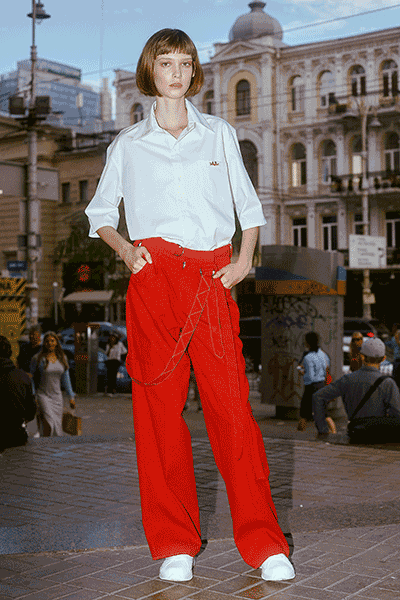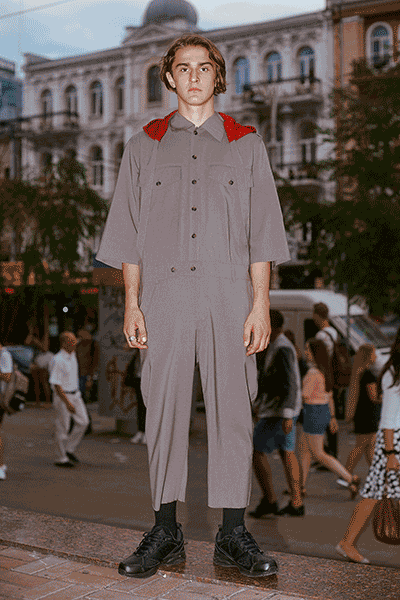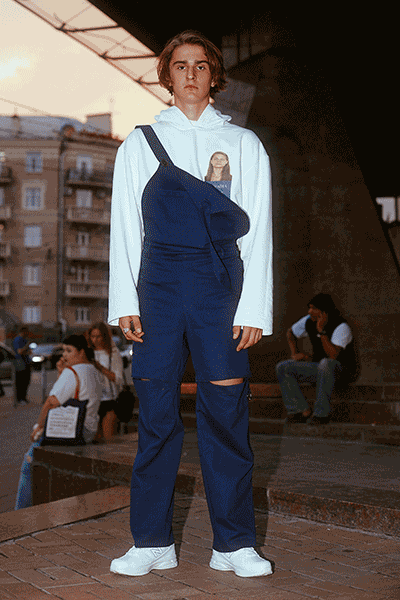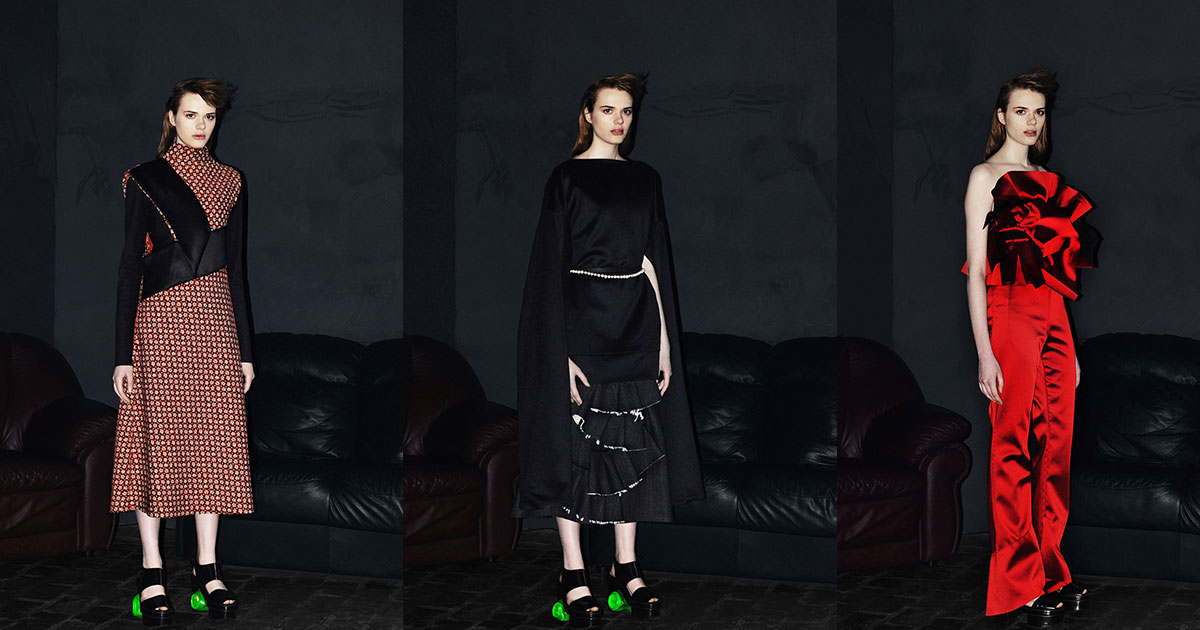La vie en rose: meet the hopeless romantic shaping Ukraine’s blossoming youth culture
At the end of August, the day before Ukraine celebrated 25 years of independence, Anton Belinskiy’s squad walked down the long hall of the Palace of Sports in Kiev. Dressed in the designer’s Spring/Summer 2017 collection, they were a vision of urban romanticism: scarlet red velvet combined with pristine white New Balance sneakers and sport socks, voluminous trench coats, oversized shirts and elements of workwear and lamé gold, chains hanging from their waists and large gold earrings spangled with rubies. The frills and folds on the garments echo the white ruched curtains draping large windows, the common trope of post-Soviet institutional elegance. Modelled by guys and girls you would probably see dancing at raves and working at local bars, Belinskiy’s clothes radiate youthful energy. It’s something Raf Simons perhaps could have channelled a couple of decades ago, but it’s coming not from Antwerp but from today’s Kiev, the capital of a country that’s only 25 years old.



From the Spring/Summer 2017 collection. Image: Armen Parsadanov
One of the most distinguished details in Belinskiy’s new collection are roses: large prints on white shirts and knitwear, small embroidery in yellow over black. There is something irresistibly romantic about these images, the intimate quality of a keepsake transformed into a contemporary outfit. It started, Belinskiy remembers, from hundreds of vintage postcards with roses.
There is something irresistibly romantic about Belinsky’s use of the image of roses, the intimate quality of a keepsake transformed into a contemporary outfit
“We went to Petrivka market and bought tons of cards with roses from the 1980s and Nineties, some of them still with faded inscriptions like ‘I love Natasha’. We scanned them and tried to look for the ones which would fit the collection. In the end we chose just a few because the prints are very strong; we also did a small embroidery, like on old-fashioned handkerchiefs,” he recalls. “I love roses, even the painted multi-coloured ones you can still find in flower kiosks. A rose is a symbol of romance, but it also verges on tackiness and beauty. It’s a very classic symbol of celebration, luxury and excess. The same goes for my collection; there are huge sleeves and shoulders, a lot of red velvet. When you give a rose, it means luxury, and at the same time it’s very accessible and common.”
Backstage at the show. Video: Stas Galaktionov
By using roses Belinskiy taps into a visually rich cultural symbol that exists in vintage cards, street signs and the dozens of 24-hour flower shops that glow softly in the night. But at the same time he is shaping the new look of youth: authentic, fresh and irresistibly romantic. “The whole collection started from the idea of the prom, not just the traditional idea of the party but more the concept of graduation, departure, entering a new phase of personal history,” Belinskiy remembers.
It’s not only about the universal idea of transition, but also about emerging Ukrainian identity: white t-shirts and sweatshirts feature prints of ID photos paired with a scan of the cover of a Ukrainian passport. “A passport is a very symbolic thing. You get it at 16 and you stay attached to it until the end of your life. You go through your whole life with this piece of paper, including the key stages, good stories and bad. The passport here is symbolic of entering a new life,” Belinskiy says.
“But of course, Ukrainian nationality is also important. If a person is born here it becomes a starting point. The kids whose portraits appear on these sweatshirts are all based in Kiev, although they all have different stories, just like me: my mum is from St Petersburg and my dad is from Israel, but I was born in Kiev so I have a Ukrainian passport. I am Ukrainian.”
Two years after the revolution that shook the streets of Kiev in 2014, Anton Belinskiy represents the search for new imagery and the growing self-awareness of a new generation of Ukrainians. At 28, he’s been running his brand for five years — exactly the time it took the fashion industry to go from a cautious curiosity about post-Soviet aesthetics to full-blown obsession with it. The search for a new otherness fuelled the post-Soviet myth: brutal charm of tower blocks and concrete, skinny boys with buzz cuts shot against the iconography of a fallen empire. The image is sincere, but ironically, just like the cultural politics of the Soviet Union, brutally homogenising. For Anton Belinskiy and the new generation of Ukrainians this aesthetics corresponds neither to the way they feel nor the way they want to be seen. They are seeking to create a new cultural framework, and their vision of youth certainly echoes Belinskiy’s roses and passport photos.
“The Nineties in Ukraine never left,” Belinskiy says. “If you go to the street, the style of the decade is still here”
In May 2016 Ukrainian singer LUNA dropped her first album, Magnets, to the joy of over 30,000 followers online. Performing under this alias, Kiev-based Kristina Bardash composes tender songs channeling the sincerity and nativity of 1990s and early 2000s pop. Paired with the DIY aesthetics of her visual presentation, they are a perfect soundtrack to a youthful longing, a nostalgia for something which you actually do not remember.
Her recent and more polished video for Butilochka follows a love story starting at a rave. The faces one sees in the flickering light are actually the same as at Anton Belinskiy’s show, and belong to the freshly casted models of Cat-b agency. Founded in 2016 by Mariia Pogrebniak and Anja Borovska, the agency is meant to represent the new faces of Ukrainian youth, that often fall beyond the conventional standards of beauty. The agency’s name is shortened from Category B, emphasizing its outsider attitude. The philosophy behind their work is also a touch romantic: “There are lots of young and reckless people around us and we wanted to collect their faces into a catalogue, like the flowers scattered around a field.”
Butilochka by LUNA (2016)
This new Ukrainian romanticism fuses nostalgia with a yearning for new beginnings, sentimentality with youthful drive, and plays with the fading ideas of good and bad taste. Anyone who’s been to Kiev will understand where it comes from. In Belinskiy’s studio a red skateboard is propped up against a wall, a voluminous pink fur coat hangs on the rail alongside some other items from his Poor But Cool collection, rose patches are scattered around the table. “Do you like the earrings?” he asks showing the gold and ruby rectangles which were in his show. “I love those, they look like what my mum could have worn when she was young.” Symbols from the past — childhood in the Nineties, vintage postcards with inscriptions — do emerge in his work. “I think the Nineties in Ukraine never left,” Belinskiy adds. “If you go to the street, the style of the decade is still here.”
While designing the collection Belinskiy rarely thinks about the past. The romantic idea for him is more about looking forward rather than back. “The new generation in Ukraine is growing and it’s really big. I admire the new parties like Cxema or Volodya. Every time I see 500 or 600 kids who I’ve never met before, they’re new, they’re interesting, listen to cool music and dress in a cool way, very forward-thinking,” he says. “When I create a collection, I think about them. When I see them I realise that I could still do something here in Kiev. Only thanks to them can I see something in this country that can change.”
Text: Anastasiia Fedorova
Top image: Dima Tolkachov







